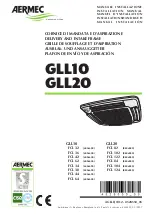
Piping
29
Liebert
®
CRV
™
General Guidelines
• Equipment damage and personal injury can result from improper piping installation, leak
checking, fluid chemistry and fluid maintenance.
• Follow local piping codes, safety codes.
• Qualified personnel must install and inspect system piping.
• Contact a local water consultant regarding water quality, corrosion protection and freeze
protection requirements.
• Install manual shutoff valves at the supply and return line to each indoor unit and drycooler to
permit routine service and emergency isolation of the unit.
NOTICE
Risk of internal system corrosion and frozen coolant fluid. Can cause equipment damage and
major fluid leaks resulting in serious building damage, expensive repair costs and costly
system down time.
Cooling coils, heat exchangers and piping systems that are connected to open cooling towers
or other open water/glycol systems are at high risk of freezing and premature corrosion.
Fluids in these systems must contain the proper antifreeze and inhibitors to prevent freezing
and premature coil, piping and heat exchanger corrosion. The water or water/glycol solution
must be analyzed by a competent local water treatment specialist before startup to establish
the inhibitor and antifreeze solution requirement and at regularly scheduled intervals
throughout the life of the system to determine the pattern of inhibitor depletion.
The complexity of water/glycol solution condition problems and the variations of required
treatment programs make it extremely important to obtain the advice of a competent and
experienced water treatment specialist and follow a regularly scheduled coolant fluid system
maintenance program.
Read and follow individual unit installation instructions for precautions regarding fluid
system design, material selection and use of field-provided devices. Liebert systems contain
iron and copper alloys that require appropriate corrosion protection. It is important to have
the system running with flow through exchangers maintained at initial system fill for 24 to 48
hours depending on size and system configuration.
Water chemistry varies greatly by location, as do the required additives, called inhibitors,
that reduce the corrosive effect of the fluids on the piping systems and components. The
chemistry of the water used must be considered, because water from some sources may
contain corrosive elements that reduce the effectiveness of the inhibited formulation.
Sediment deposits prevent the formation of a protective oxide layer on the inside of the
coolant system components and piping. The water/coolant fluid must be treated and
circulating through the system continuously to prevent the buildup of sediment deposits and
or growth of sulfate reducing bacteria.
Proper inhibitor maintenance must be performed in order to prevent corrosion of the system.
Consult glycol manufacturer for testing and maintenance of inhibitors.
Commercial ethylene glycol (examples are Dow Chemical Dowtherm SR-1 Union Carbide
Ucartherm and Texaco E.G. Heat Transfer Fluid 100), when pure, is generally less corrosive
to the common metals of construction than water itself. It will, however, assume the
corrosivity of the water from which it is prepared and may become increasingly corrosive with
use if not properly inhibited.
NOTICE
Risk of no-flow condition. Can cause equipment damage.
Do not leave the unit in a no-flow condition. Idle fluid allows the collection of sediment that
prevents the formation of a protective oxide layer on the inside of tubes. Keep unit switched
on and system pump operating continuously.
















































